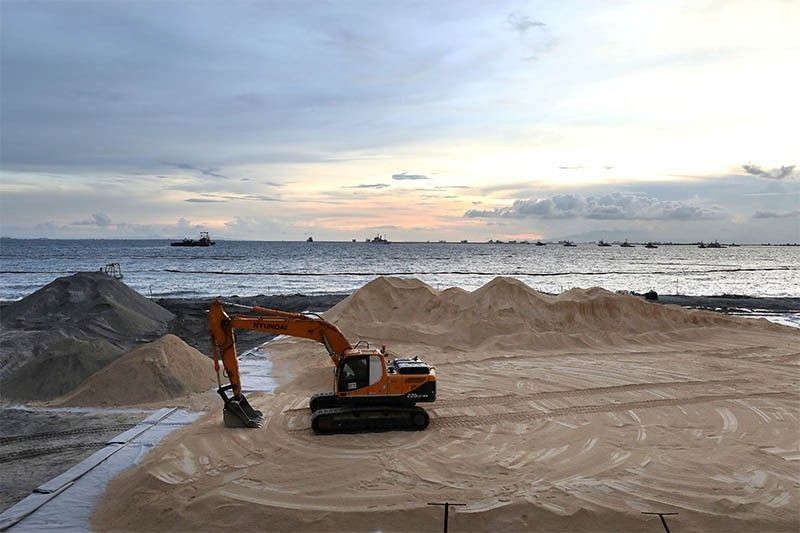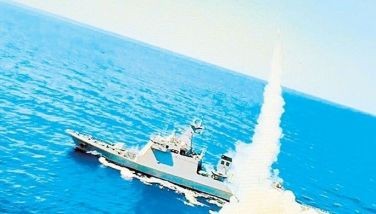DENR on fish kill cause: Dolomite? Impossible; Sabotage? Maybe

MANILA, Philippines — The Department of the Environment and Natural Resources denied Thursday the allegation that the dumping of crushed dolomite rocks along the shore of Manila Bay was behind the fishkill in Baseco.
It is impossible to link the overlaying of artificial sand made from pulverized dolomite rocks to fish dying in Baseco because of the distance to the baywalk area, the direction of the wind and the presence of a breakwater, DENR Undersecretary Benny Antiporda said.
"If you will look at the distance, it is really far. At the same time, the wind direction, which is habagat (southwest monsoon)," Antiporda told reporters in Filipino.
"There’s a big divide, which is a breakwater. So it’s really impossible that it came from the beach nourishment area," he added.
Residents of Baseco compound in Tondo, Manila were surprised to see dead fish floating along the sea wall area of Manila Bay, organization Urban Poor Associates posted on Facebook Thursday morning, adding the coastal community was worried the incident might be an effect of the dumping of dolomite sand.
But Antiporda said the allegation was “very erroneous” and that the incident might be an “isolated case”
“If that happened in the nourishment area, would you imagine, the dead fish should be in the pier, the Manila Bay baywalk area,” he said.
He said the department is investigating the incident and studying the water quality where the fishkill happened.
BFAR: Fish died due to dissolved oxygen
In a statement Thursday, the Bureau of Fisheries and Aquatic Resources said it had received report that on the early morning of September 15, residents found biya, kanduli, asohos and tilapia gasping for air following a heavy rainfall, which lasted almost a day.
The bureau’s water quality analysis found that the water quality in Baseco areas indicated a “very low level” of dissolved oxygen (DO) at 0.11 mg/L. The acceptable level of DO—the volume of oxygen that is contained in water and important in supporting aquatic life—for marine waters is 5 mg/L.
BFAR said that consuming fish which have died due to dissolved oxygen depletion is not entirely harmful. But it cautioned against consumption of dead fish and other species from the area to prevent possible harm to human health, “especially if these fish have already shown signs of decomposition like bloatedness, disintegration of parts and foul smell.”
It added there is no more reported incident of fish mortality in Manila Bay.
Fishkill last year
DENR’s Antiporda also pointed out that fish kill happened in Manila Bay before.
Last year, a fish kill incident occurred at Las Piñas-Parañaque Critical Habitat and Eco-Tourism Area on October 10, 2019. An analysis of the DENR-Environmental Management Bureau found that three of the stations where water samples were collected was lower than the acceptable level of DO.
Four stations also had traces of cyanide, a chemical used in illegal fishing. “It blocks the absorption of oxygen by cells and causes the species to suffocate and die,” the EMB report explained.
“Sabotage, we are not discounting that. We are still investigating,” Antiporda said, adding later that there might be desperate moves to discredit the government.
Government officials have said that the project to build an artificial beach along Manila Bay’coastline is part of the government’s program to rehabilitate the degraded bay. They also said that the crushed dolomite sand will prevent erosion and neutralize the acidity of the water.
But for environment, fishers and religious groups, the project will pose harm not only to the bay’s marine ecosystem but also to communities around the area. The Department of Health, however, said the crushed dolomite rocks used for the project do not pose health hazards.
Critics of the bay also stressed that the project violated at least five laws on the environment and culture and failed to undergo consultation with stakeholders.
Related video:
- Latest
- Trending






























